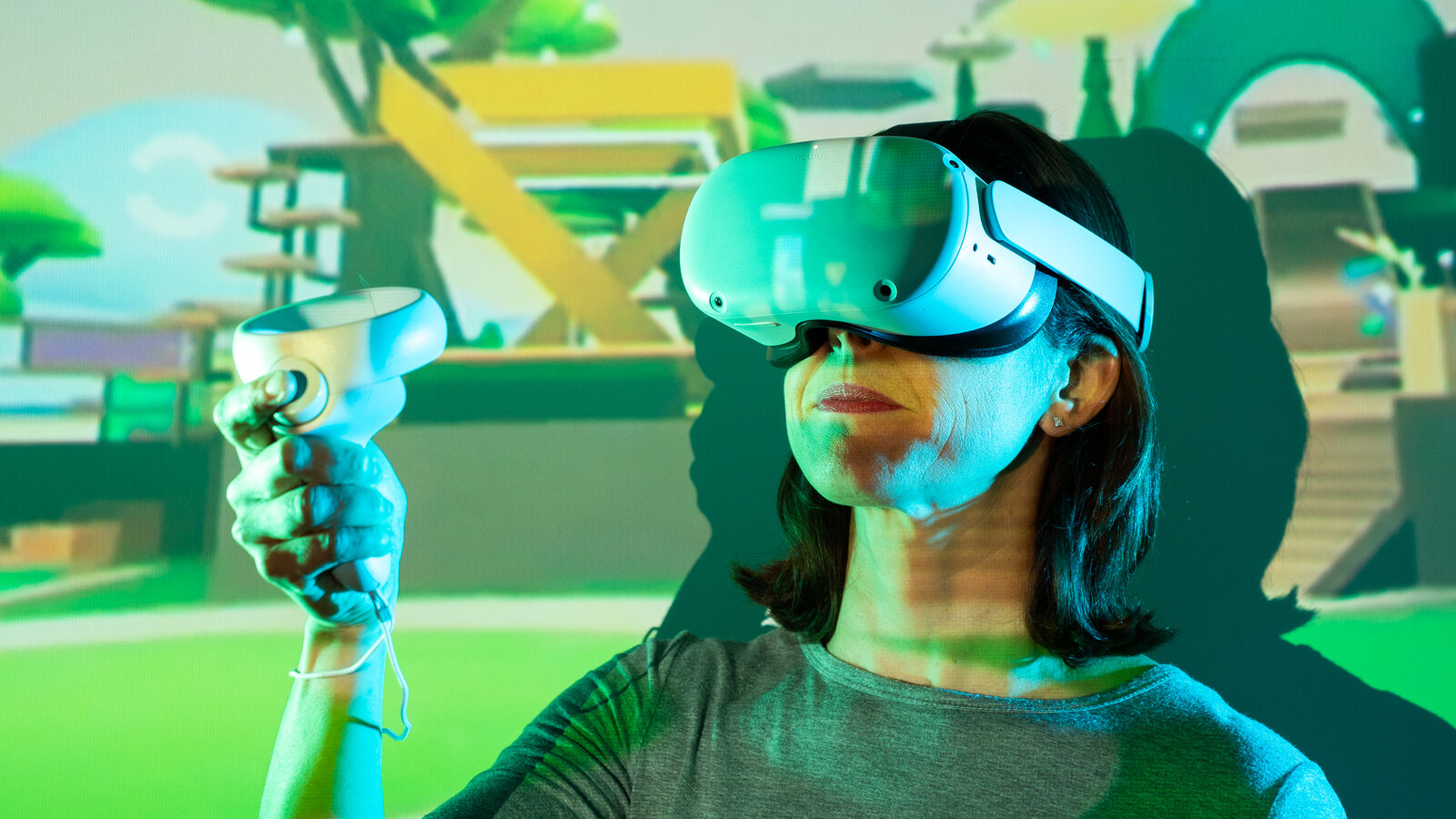Introduction
Welcome to the exciting world of the Metaverse, where virtual reality and augmented reality converge to create immersive digital experiences. The Metaverse is a rapidly evolving concept that has gained immense popularity in recent years. With its potential to revolutionize industries and reshape social interactions, the Metaverse has captured the imagination of people around the globe.
But what exactly is the Metaverse? In simple terms, it is a virtual universe, a collective space consisting of interconnected digital spaces, platforms, and experiences. It transcends traditional 2D screens and allows individuals to interact with a three-dimensional, computer-generated environment in real time.
The concept of the Metaverse has been popularized by science fiction and movies, envisioning a futuristic world where people can escape reality and engage in limitless possibilities. However, what was once considered a fictional concept is gradually becoming a reality, thanks to advancements in technology and the growing adoption of virtual reality and augmented reality devices.
Countless companies and tech giants are investing heavily in the development of the Metaverse, creating immersive experiences, virtual worlds, and virtual marketplaces. As a result, a wide range of applications is emerging, spanning gaming, entertainment, education, communication, and even commerce.
As the Metaverse expands, one question arises: how many users are currently engaged in this virtual ecosystem? Estimating the number of Metaverse users is not a straightforward task, primarily due to the decentralized and fragmented nature of the Metaverse itself. Nevertheless, industry reports, user data, and surveys provide insights into the growing popularity of the Metaverse and the number of individuals already participating in this digital phenomenon.
In the following sections, we will explore the current state of the Metaverse, analyze the growth of its user base, examine the factors influencing the number of Metaverse users, delve into the demographics of these users, and discuss the challenges in accurately estimating the total number of participants. So, let’s dive into this virtual realm and uncover the secrets of the Metaverse.
What is the Metaverse?
The Metaverse is a term that has gained popularity in recent years, but what exactly does it mean? The Metaverse refers to a virtual universe, a collective space where individuals can interact with a three-dimensional, computer-generated environment in real time. It goes beyond traditional 2D screens and offers a more immersive and interactive experience.
Imagine stepping into a virtual world where you can explore vast landscapes, interact with other users, build and customize your own digital avatar, and participate in a wide range of activities. From gaming and entertainment to education and commerce, the possibilities within the Metaverse are endless.
The Metaverse is not limited to a single platform or application. It is a decentralized and interconnected ecosystem consisting of various virtual worlds, platforms, and experiences. Users can access the Metaverse through virtual reality (VR) headsets, augmented reality (AR) devices, and even traditional screens.
In the Metaverse, individuals have the freedom to create their own virtual spaces, whether it’s a virtual home, a virtual office, or an entire virtual world. They can socialize with friends and strangers, attend virtual events and concerts, and participate in collaborative projects and simulations.
One key aspect of the Metaverse is its potential to revolutionize industries and reshape social interactions. For example, in the gaming industry, the Metaverse offers a more immersive and interactive gaming experience, blurring the line between the virtual and the real. It allows players to fully immerse themselves in virtual worlds, collaborating with other players and engaging in complex narratives.
Beyond gaming, the Metaverse has the potential to transform education by providing interactive and immersive learning experiences. Students can explore historical sites, simulate scientific experiments, and participate in virtual classrooms with peers from around the world.
Furthermore, the Metaverse has implications for e-commerce and virtual marketplaces. Users can browse and purchase virtual products, create and sell virtual assets, and even establish virtual businesses within this digital realm.
The Metaverse is a concept that is still evolving and expanding, with numerous companies and tech giants investing in its development. It represents a new frontier of technology and has the potential to reshape the way we live, work, and play. As the Metaverse continues to grow, so too does the excitement and anticipation surrounding its possibilities.
How many Metaverse users are there?
Estimating the exact number of Metaverse users is a complex task due to the decentralized and fragmented nature of the Metaverse itself. However, various reports and data provide insights into the growing popularity and widespread adoption of the Metaverse.
According to a survey conducted by Statista, the number of active virtual reality users reached approximately 171 million in 2020, and this number is expected to grow to around 216 million by 2023. These figures represent individuals who engage with virtual reality experiences, which often overlap with the Metaverse.
Additionally, the rapid growth of augmented reality (AR) devices, such as smartphones and smart glasses, further contributes to the expansion of the user base engaging with the Metaverse. As more people adopt AR technologies, the barrier to entry for exploring the Metaverse becomes lower.
Companies at the forefront of the Metaverse, such as Facebook (now Meta), Microsoft, and Epic Games, also provide valuable insights into user engagement. Facebook’s virtual reality platform, Oculus, has sold millions of units worldwide, indicating a significant number of users with access to virtual reality experiences. Similarly, Microsoft’s mixed reality platform, HoloLens, and Epic Games’ Fortnite virtual world have amassed large user bases, demonstrating considerable participation in the Metaverse.
While these figures provide a glimpse into the scale of Metaverse users, it’s important to note that the Metaverse extends beyond specific platforms or applications. It comprises a multitude of virtual worlds, virtual marketplaces, and social platforms, each with its own user base.
Furthermore, the growing popularity of blockchain-based virtual worlds, such as Decentraland and Somnium Space, introduces a new dimension to the Metaverse. These virtual worlds leverage blockchain technology to enable users to own, buy, sell, and trade virtual land and virtual assets. The user base of these platforms continues to grow as more individuals recognize the potential for ownership and financial opportunities within the Metaverse.
As the Metaverse expands and becomes more accessible, it is expected that the number of users will continue to increase. Advancements in technology, improvements in user experience, and the development of compelling content and applications will play a significant role in attracting and retaining users within the Metaverse.
It is worth mentioning that the exact number of Metaverse users is challenging to determine due to the vastness and continuous evolution of this digital realm. However, it is undeniable that the Metaverse is experiencing significant growth and capturing the attention of individuals worldwide.
Growth of Metaverse users
The Metaverse is experiencing rapid growth in its user base, fueled by advancements in technology, increasing accessibility, and a growing interest in virtual reality and augmented reality experiences. This growth can be seen through various indicators and trends within the digital landscape.
One of the key drivers of the growth of Metaverse users is the expansion of virtual reality (VR) and augmented reality (AR) devices. These technologies have become more accessible and affordable over the years, attracting a larger audience. VR headsets, such as Oculus Quest and HTC Vive, have gained popularity, allowing users to immerse themselves in virtual worlds and experiences.
In addition, the widespread use of smartphones and the integration of AR functionalities have introduced more individuals to the concept of the Metaverse. AR apps, like Pokémon Go, have garnered millions of users and showcased the potential of blending digital experiences with the real world.
The COVID-19 pandemic has also played a role in the growth of Metaverse users. With physical distancing measures in place, people turned to virtual platforms and experiences for entertainment, socialization, and work. Virtual meetings, events, and concerts became commonplace, further driving the adoption of the Metaverse.
Furthermore, the increasing investment and development in the Metaverse by tech giants and companies have resulted in a wider range of compelling content and applications. Virtual worlds, gaming experiences, educational platforms, and virtual marketplaces offer diverse opportunities for users to engage and explore the Metaverse. This expansion of options attracts new users and encourages existing users to continue their participation.
Moreover, the integration of blockchain technology within the Metaverse has sparked additional growth. Blockchain-based virtual worlds enable users to truly own digital assets and participate in decentralized economies. The promise of ownership and financial opportunities within the Metaverse has attracted a new wave of users seeking alternative digital experiences.
In recent years, we have witnessed a significant increase in the number of virtual events, conferences, and exhibitions hosted within the Metaverse. These events provide interactive and immersive experiences, attracting attendees from around the world. The growth of these virtual events further highlights the expanding user base of the Metaverse.
It’s important to note that the growth of Metaverse users is expected to continue as technology continues to advance and adoption becomes more widespread. As VR and AR technologies evolve, becoming more seamless, comfortable, and user-friendly, more people will be inclined to explore the Metaverse and engage in its immersive experiences.
Overall, the growth of Metaverse users is driven by increasing accessibility, technological advancements, engaging content, and the integration of blockchain. As the Metaverse becomes more integrated into our daily lives, we can anticipate even greater growth and evolution in the years to come.
Factors influencing the number of Metaverse users
The number of Metaverse users is influenced by various factors that shape the adoption and engagement within this digital realm. Understanding these factors provides insights into the growth and dynamics of the Metaverse community.
1. Technological advancements: The advancement of virtual reality (VR) and augmented reality (AR) technologies plays a crucial role in attracting users to the Metaverse. The development of more immersive, comfortable, and affordable devices enhances the overall user experience, making it more accessible and enjoyable.
2. Content and applications: The availability of diverse and compelling content within the Metaverse is a significant driver for user engagement. Virtual worlds, gaming experiences, educational platforms, and virtual marketplaces all contribute to the appeal of the Metaverse and attract users with various interests and preferences.
3. Community and social interaction: The sense of community and social interaction within the Metaverse is a key factor in user acquisition and retention. Users seek opportunities to connect, collaborate, and communicate with others, fostering a sense of belonging and shared experiences.
4. Integration with real-world activities: When the Metaverse seamlessly integrates with real-world activities, it becomes more appealing to a broader audience. Applications that enhance productivity, education, and entertainment in the real world while incorporating elements of the Metaverse can attract users who may not have considered virtual experiences otherwise.
5. Accessibility and affordability: The accessibility and affordability of Metaverse technologies and experiences play a significant role in driving user adoption. As VR and AR devices become more affordable and accessible to a wider range of individuals, the barrier to entry for exploring the Metaverse is lowered.
6. Industry partnerships and collaborations: Collaborations between tech giants, content creators, and brands contribute to the growth of the Metaverse. Partnerships can leverage existing user bases, enhance content creation, and provide unique experiences that engage both existing and new users.
7. Education and awareness: Educating and raising awareness about the Metaverse and its potential benefits is crucial for attracting users. As more individuals become familiar with the concept and understand the value it offers, they are more likely to explore and engage with the Metaverse.
8. Privacy and security: The concerns surrounding privacy and security in the digital space can influence user adoption. Developers and platform operators must address these concerns by implementing robust privacy measures and ensuring a safe environment for users to participate in the Metaverse.
9. Cultural and regional differences: Cultural and regional differences can impact the adoption and engagement of the Metaverse. Factors such as language barriers, cultural preferences, and regulatory environments may affect the availability and acceptance of Metaverse experiences in certain regions.
10. Integration of blockchain technology: The integration of blockchain technology within the Metaverse offers unique opportunities for ownership, financial transactions, and decentralized governance. The promise of true digital asset ownership and the potential for financial rewards are factors that attract users to blockchain-based virtual worlds within the Metaverse.
By understanding and leveraging these factors, stakeholders in the Metaverse ecosystem can enhance user acquisition, engagement, and overall experience, driving continued growth and innovation within this digital realm.
Demographics of Metaverse users
The demographics of Metaverse users vary across different platforms, applications, and virtual worlds. While it is challenging to obtain precise data on user demographics, several trends and studies shed light on the characteristics of Metaverse users.
One notable trend is the predominance of younger generations in the Metaverse. Millennials and Generation Z make up a significant portion of Metaverse users, as they are more likely to embrace new technologies and digital experiences. These demographics have grown up in a digitally connected world and are accustomed to immersive virtual interactions.
Additionally, male users tend to be more prominent in the Metaverse, particularly in gaming-related virtual worlds. However, this trend is gradually shifting as more diverse content, applications, and inclusive experiences are developed to attract users of all genders.
The geographic distribution of Metaverse users is also notable. While the Metaverse has a global reach, certain regions, such as North America, Europe, and East Asia, have higher concentrations of users. This is often influenced by factors such as access to technology, internet infrastructure, and cultural preferences.
Socioeconomic factors can also impact the demographics of Metaverse users. Access to VR and AR devices, internet connectivity, and disposable income can influence the ability of individuals to participate in the Metaverse. However, as technology becomes more affordable and accessible, the user base is expected to become more diverse in terms of socioeconomic backgrounds.
Another aspect of Metaverse demographics is the interest and participation of different professional fields. Professionals in fields such as gaming, design, tech, and creative arts are more likely to engage with the Metaverse, as these industries often have a natural affinity for immersive digital experiences. However, as the Metaverse expands into areas such as education, healthcare, and commerce, professionals from various domains are expected to participate and contribute.
As the Metaverse continues to evolve, efforts are being made to create a more inclusive and diverse user base. Content creators, platform operators, and developers are working to provide experiences that cater to a wide range of demographics, including different age groups, genders, and cultural backgrounds.
It is important to note that these demographics are not static and are subject to change as the Metaverse becomes more mainstream and accessible. As technology advances, costs decrease, and content becomes more diverse, the demographics of Metaverse users are likely to evolve and become more representative of the global population.
Understanding the demographics of Metaverse users is crucial for creators, developers, and businesses to tailor their offerings and ensure inclusivity within the Metaverse. By embracing diversity and catering to the needs and preferences of various demographics, the Metaverse can become a more vibrant and inclusive digital space for all users.
Challenges in estimating Metaverse users
Estimating the exact number of Metaverse users is a challenging endeavor due to several factors that contribute to the complexity of gathering accurate data. These challenges include:
1. Fragmentation and decentralization: The Metaverse consists of a vast and decentralized ecosystem comprising numerous virtual worlds, platforms, and experiences. Each of these entities may have its own user base, making it difficult to obtain a comprehensive count of Metaverse users as a whole.
2. Lack of standardized metrics: The absence of standardized metrics for measuring Metaverse usage poses a challenge in estimating user numbers. Different platforms and applications may track and report user data differently, making it challenging to compare and aggregate data accurately.
3. Privacy concerns: User privacy is a priority in the digital realm, and this can hinder the collection of accurate user data for estimating Metaverse users. Striking a balance between data collection and user privacy is crucial, which may limit the amount and accuracy of available data.
4. Duplication and multiple accounts: Users may have multiple accounts across different platforms and virtual worlds within the Metaverse. This duplication can lead to overestimation of user numbers if each account is counted separately, or underestimation if duplicate accounts are not accounted for.
5. Lack of universal access: Not everyone has equal access to Metaverse technologies and experiences due to factors such as geographical location, economic disparities, and technological limitations. This lack of universal access can affect the accuracy and representativeness of user estimates.
6. Dynamic and evolving nature of the Metaverse: The Metaverse is a rapidly evolving concept with new platforms, applications, and experiences constantly emerging. User numbers can fluctuate as users transition between different virtual worlds or platforms, making it challenging to obtain a static figure.
7. Dependence on self-reported data: Much of the data available on Metaverse user numbers relies on self-reported data from platform operators and surveys. While efforts are made to ensure accuracy, this dependence on self-reported data introduces the potential for biases and inaccuracies in the estimation process.
8. Lack of comprehensive data sharing: Data sharing among Metaverse platforms and applications can be limited, hindering the ability to obtain a holistic view of user numbers. This lack of comprehensive data sharing further contributes to the difficulty in estimating Metaverse users.
Despite these challenges, industry reports, market research, and user surveys provide valuable insights into the growth and popularity of the Metaverse. While exact figures may be elusive, trends and patterns can still be identified, enabling us to understand the broad scope and impact of the Metaverse on user engagement and digital experiences.
Conclusion
The Metaverse is a dynamic and rapidly evolving digital realm that is capturing the imagination of people worldwide. With its immersive virtual experiences, diverse content, and potential to transform various industries, the Metaverse is becoming an integral part of our digital lives.
While estimating the exact number of Metaverse users is challenging due to the decentralized and fragmented nature of this virtual universe, it is clear that the user base is steadily growing. Advancements in technology, increasing accessibility, and a growing interest in virtual reality and augmented reality experiences are driving the adoption and engagement within the Metaverse.
Factors such as technological advancements, compelling content and applications, community and social interaction, integration with real-world activities, accessibility and affordability, industry partnerships and collaborations, education and awareness, privacy and security, cultural and regional differences, and the integration of blockchain technology influence the number and demographics of Metaverse users.
Despite challenges in collecting accurate user data, insights from industry reports, surveys, and user trends shed light on the expansion and impact of the Metaverse. While precise figures may be elusive, it is evident that the Metaverse is attracting a diverse and growing user base.
As the Metaverse continues to evolve, it is crucial for stakeholders to consider the diverse needs and preferences of users, cultivate inclusivity, and create engaging experiences that cater to a wide range of demographics. With ongoing advancements in technology, continued efforts in education and awareness, and a focus on user privacy and security, the Metaverse will likely become an even more prominent presence in our digital landscape.
As we navigate this exciting digital frontier, the true potential of the Metaverse is yet to be fully realized. The Metaverse has the power to reshape industries, revolutionize social interactions, and offer new possibilities for individuals and communities. It is a realm brimming with creativity, innovation, and exploration, inviting us to step into a world of limitless opportunities.

























